|
Our Services Follow Us
Benefits of In Home Personal Training
-Personal Trainers in Maryland
-Personal Trainers in Pennsylvania
-Personal Trainers in Virginia
Every Body's Personal Trainer Accessories
Free Resources Personal Trainer/Owner Eric Leader's Blog
Company Information Every Body's Personal Trainer in the Media/Press
Physique Transformation Competition
Every Body's Personal Trainer Client Feedback
Call Now!!! (443) 615-2702 Or
Follow Us
|
Eat More, Weigh Less?
How to manage your weight without being hungry.
Have you tried to lose weight by cutting down the amount of food you eat? Do you still feel hungry and not satisfied after eating? Or have you avoided trying to lose weight because you're afraid of feeling hungry all the time? If so, you are not alone. Many people throw in the towel on weight loss because they feel deprived and hungry when they eat less. But there is another way. Aim for a slow, steady weight loss by decreasing calorie intake while maintaining an adequate nutrient intake and increasing physical activity. You can cut calories without eating less nutritious food. The key is to eat foods that will fill you up without eating a large amount of calories.
If I cut calories, won't I be hungry?
Research shows that people get full by the amount of food they eat, not the number of calories they take in. You can cut calories in your favorite foods by lowering the amount of fat and or increasing the amount of fiber-rich ingredients, such as vegetables or fruit.
Let's take macaroni and cheese as an example. The original recipe uses whole milk, butter, and full-fat cheese. This recipe has about 540 calories in one serving (1 cup).
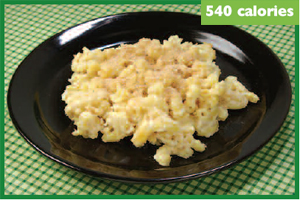
Here's how to remake this recipe with fewer calories and less fat:
| Use 2 cups non-fat milk instead of 2 cups whole milk. | |
| Use 8 ounces light cream cheese instead of 21⁄4 cups full-fat cheddar cheese. | |
| Use 1 tablespoon butter instead of 2 or use 2 tablespoons of soft trans-fat free margarine. | |
| Add about 2 cups of fresh spinach and 1 cup diced tomatoes (or any other veggie you like). |
Your redesigned mac and cheese now has 315 calories in one serving (1 cup). You can eat the same amount of mac and cheese with 225 fewer calories.
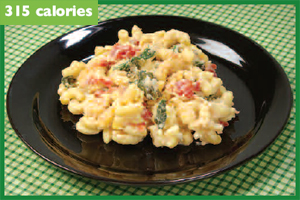
What foods will fill me up?
To be able to cut calories without eating less and feeling hungry, you need to replace some higher calorie foods with foods that are lower in calories and fat and will fill you up. In general, this means foods with lots of water and fiber in them. The chart below will help you make smart food choices that are part of a healthy eating plan.
| These foods
will fill you up with less calories. Choose them more often… |
These foods can pack more calories into each bite. Choose them less often… |
|---|---|
| Fruits and Vegetables (prepared without added fat) |
Fried foods |
| Spinach, broccoli, tomato, carrots, watermelon, berries, apples | Eggs fried in butter, fried vegetables, French fries |
| Low-fat and fat-free milk products | Full-fat milk products |
| Low- or fat-free milk, low or
fat-free yogurt, low- or fat-free cottage cheese |
Full-fat cheese, full-fat ice
cream, whole and 2% milk |
| Broth-based soup | Dry snack foods |
| Vegetable-based soups, soups with chicken or beef broth, tomato soups (without cream) | Crackers or pretzels, cookies, chips, dried fruits |
| Whole grains | Higher-fat and higher-sugar foods |
| Brown rice, whole wheat bread,
whole wheat pastas, popcorn |
Croissants,margarine, shortening
and butter, doughnuts, candy bars, cakes and pastries |
| Lean meat, poultry and fish | Fatty cuts of meat |
| Grilled salmon, chicken breast
without skin, ground beef (lean or extra lean) |
Bacon, brisket, ground beef (regular) |
| Legumes (beans and peas) | |
| Black, red kidney and pinto beans (without added fat), green peas, black-eyed peas |
A healthy eating plan is one that —
| Emphasizes fruits, vegetables, whole grains, and fat free or low-fat milk and milk products. | |
| Includes lean meats, poultry, fish, beans, eggs, and nuts. | |
| Is low in saturated fats, trans fats, cholesterol, salt (sodium), and added sugars. | |
| Stays within your calorie needs. |
| Technically speaking… |
|---|
| The number of calories in a
particular amount or weight of food is called “calorie density” or “energy
density.” Low-calorie-dense foods are ones that don't pack a lot of calories
into each bite. Foods that have a lot of water or fiber and little fat are usually low in calorie density. They will help you feel full without an unnecessary amount of calories. |
Here are some more ideas for cutting back on calories without eating less and being hungry:
| Instead of... | Try... |
|---|---|
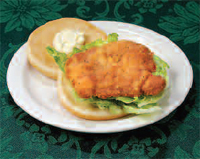 Fried chicken sandwich with 1 tbsp. mayonnaise = 599 calories |
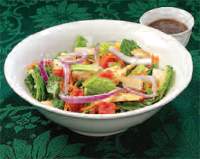 Grilled chicken salad with low-fat dressing 2 cups lettuce, 2 oz. grilled chicken breast, 2 tbsp. light balsamic vinaigrette dressing = 178 calories |
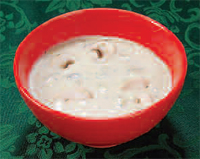 Cream-based soup 1 cup mushroom bisque = 400 calories |
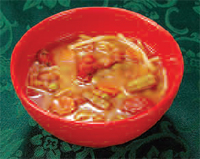 Broth-based soup 1 cup minestrone = 112 calories |
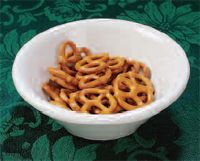 Chips or pretzels 1.5 oz. pretzels = 162 calories |
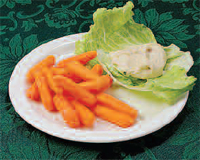 Baby carrots with hummus 16 baby carrots with 1 tbsp. hummus = 75 calories |
Good things can come in big packages!
People eat more than they realize when faced with large portion sizes. This usually means eating too many calories. But, not all large portions are created equal. Larger portions of water- and fiber-rich foods, like fruits, vegetables, and broth-based soups, can fill you up with less calories. Start with an appetizer. Research shows that if you eat a low-calorie appetizer before a meal, you will eat fewer total calories during the meal. Start your meals with a broth-based soup or a green salad without a large amount of cheese, or croutons.
Fruits and veggies: keep it simple!
Most fruits and veggies are low-calorie and will fill you up, but the way you prepare them can change that. Breading and frying, and using high-fat creams or butter with vegetables and fruit will add extra calories. Try steaming vegetables and using spices and low-fat sauces for flavor. And enjoy the natural sweetness of raw fruit.
What about beverages?
While drinking beverages is important to good health, they don't help you feel full and satisfied the way food does. Choose drinks without calories, like water, sparkling water, or unsweetened iced tea. Drink fat-free or low-fat milk instead of 2% or whole milk.